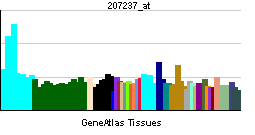KCNA3
| Potassium voltage-gated channel, shaker-related subfamily, member 3 | |||||||||||||
|---|---|---|---|---|---|---|---|---|---|---|---|---|---|
|
File:PBB Protein KCNA3 image.jpg PDB rendering based on 1dsx. | |||||||||||||
| |||||||||||||
| Identifiers | |||||||||||||
| Symbols | KCNA3 ; PCN3; HGK5; HLK3; HPCN3; HUKIII; KV1.3; MK3 | ||||||||||||
| External IDs | Template:OMIM5 Template:MGI HomoloGene: 20513 | ||||||||||||
| |||||||||||||
| RNA expression pattern | |||||||||||||
 | |||||||||||||
| More reference expression data | |||||||||||||
| Orthologs | |||||||||||||
| Template:GNF Ortholog box | |||||||||||||
| Species | Human | Mouse | |||||||||||
| Entrez | n/a | n/a | |||||||||||
| Ensembl | n/a | n/a | |||||||||||
| UniProt | n/a | n/a | |||||||||||
| RefSeq (mRNA) | n/a | n/a | |||||||||||
| RefSeq (protein) | n/a | n/a | |||||||||||
| Location (UCSC) | n/a | n/a | |||||||||||
| PubMed search | n/a | n/a | |||||||||||
Potassium voltage-gated channel, shaker-related subfamily, member 3, also known as KCNA3 or Kv1.3, is a human gene.[1]
Potassium channels represent the most complex class of voltage-gated ion channels from both functional and structural standpoints. Their diverse functions include regulating neurotransmitter release, heart rate, insulin secretion, neuronal excitability, epithelial electrolyte transport, smooth muscle contraction, and cell volume. Four sequence-related potassium channel genes - shaker, shaw, shab, and shal - have been identified in Drosophila, and each has been shown to have human homolog(s). This gene encodes a member of the potassium channel, voltage-gated, shaker-related subfamily. This member contains six membrane-spanning domains with a shaker-type repeat in the fourth segment. It belongs to the delayed rectifier class, members of which allow nerve cells to efficiently repolarize following an action potential. It plays an essential role in T-cell proliferation and activation. This gene appears to be intronless and it is clustered together with KCNA2 and KCNA10 genes on chromosome 1.[1]
See also
References
Further reading
- Gutman GA, Chandy KG, Grissmer S; et al. (2006). "International Union of Pharmacology. LIII. Nomenclature and molecular relationships of voltage-gated potassium channels". Pharmacol. Rev. 57 (4): 473–508. doi:10.1124/pr.57.4.10. PMID 16382104.
- Attali B, Romey G, Honoré E; et al. (1992). "Cloning, functional expression, and regulation of two K+ channels in human T lymphocytes". J. Biol. Chem. 267 (12): 8650–7. PMID 1373731.
- Cai YC, Osborne PB, North RA; et al. (1992). "Characterization and functional expression of genomic DNA encoding the human lymphocyte type n potassium channel". DNA Cell Biol. 11 (2): 163–72. PMID 1547020.
- Philipson LH, Hice RE, Schaefer K; et al. (1991). "Sequence and functional expression in Xenopus oocytes of a human insulinoma and islet potassium channel". Proc. Natl. Acad. Sci. U.S.A. 88 (1): 53–7. PMID 1986382.
- Grissmer S, Dethlefs B, Wasmuth JJ; et al. (1991). "Expression and chromosomal localization of a lymphocyte K+ channel gene". Proc. Natl. Acad. Sci. U.S.A. 87 (23): 9411–5. PMID 2251283.
- Folander K, Douglass J, Swanson R (1995). "Confirmation of the assignment of the gene encoding Kv1.3, a voltage-gated potassium channel (KCNA3) to the proximal short arm of human chromosome 1". Genomics. 23 (1): 295–6. doi:10.1006/geno.1994.1500. PMID 7829094.
- Bock J, Szabó I, Jekle A, Gulbins E (2002). "Actinomycin D-induced apoptosis involves the potassium channel Kv1.3". Biochem. Biophys. Res. Commun. 295 (2): 526–31. PMID 12150982.
- Strausberg RL, Feingold EA, Grouse LH; et al. (2003). "Generation and initial analysis of more than 15,000 full-length human and mouse cDNA sequences". Proc. Natl. Acad. Sci. U.S.A. 99 (26): 16899–903. doi:10.1073/pnas.242603899. PMID 12477932.
- Panyi G, Bagdány M, Bodnár A; et al. (2003). "Colocalization and nonrandom distribution of Kv1.3 potassium channels and CD3 molecules in the plasma membrane of human T lymphocytes". Proc. Natl. Acad. Sci. U.S.A. 100 (5): 2592–7. doi:10.1073/pnas.0438057100. PMID 12604782.
- Hajdú P, Varga Z, Pieri C; et al. (2003). "Cholesterol modifies the gating of Kv1.3 in human T lymphocytes". Pflugers Arch. 445 (6): 674–82. doi:10.1007/s00424-002-0974-y. PMID 12632187.
- Storey NM, Gómez-Angelats M, Bortner CD; et al. (2003). "Stimulation of Kv1.3 potassium channels by death receptors during apoptosis in Jurkat T lymphocytes". J. Biol. Chem. 278 (35): 33319–26. doi:10.1074/jbc.M300443200. PMID 12807917.
- Preussat K, Beetz C, Schrey M; et al. (2003). "Expression of voltage-gated potassium channels Kv1.3 and Kv1.5 in human gliomas". Neurosci. Lett. 346 (1–2): 33–6. PMID 12850541.
- Mackenzie AB, Chirakkal H, North RA (2003). "Kv1.3 potassium channels in human alveolar macrophages". Am. J. Physiol. Lung Cell Mol. Physiol. 285 (4): L862–8. doi:10.1152/ajplung.00095.2003. PMID 12909584.
- Grunnet M, Rasmussen HB, Hay-Schmidt A; et al. (2004). "KCNE4 is an inhibitory subunit to Kv1.1 and Kv1.3 potassium channels". Biophys. J. 85 (3): 1525–37. PMID 12944270.
- Panyi G, Vámosi G, Bacsó Z; et al. (2004). "Kv1.3 potassium channels are localized in the immunological synapse formed between cytotoxic and target cells". Proc. Natl. Acad. Sci. U.S.A. 101 (5): 1285–90. doi:10.1073/pnas.0307421100. PMID 14745040.
- Gerhard DS, Wagner L, Feingold EA; et al. (2004). "The status, quality, and expansion of the NIH full-length cDNA project: the Mammalian Gene Collection (MGC)". Genome Res. 14 (10B): 2121–7. doi:10.1101/gr.2596504. PMID 15489334.
- Szabò I, Bock J, Jekle A; et al. (2005). "A novel potassium channel in lymphocyte mitochondria". J. Biol. Chem. 280 (13): 12790–8. doi:10.1074/jbc.M413548200. PMID 15632141.
- Rus H, Pardo CA, Hu L; et al. (2005). "The voltage-gated potassium channel Kv1.3 is highly expressed on inflammatory infiltrates in multiple sclerosis brain". Proc. Natl. Acad. Sci. U.S.A. 102 (31): 11094–9. doi:10.1073/pnas.0501770102. PMID 16043714.
- Mullen KM, Rozycka M, Rus H; et al. (2006). "Potassium channels Kv1.3 and Kv1.5 are expressed on blood-derived dendritic cells in the central nervous system". Ann. Neurol. 60 (1): 118–27. doi:10.1002/ana.20884. PMID 16729292.
External links
- Kv1.1+Potassium+Channel at the US National Library of Medicine Medical Subject Headings (MeSH)
- KCNA1+protein,+human at the US National Library of Medicine Medical Subject Headings (MeSH)
| Stub icon | This membrane protein–related article is a stub. You can help Wikipedia by expanding it. |
This article incorporates text from the United States National Library of Medicine, which is in the public domain.